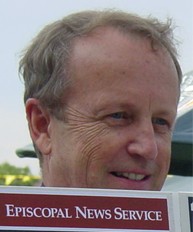James E. Solheim, best known as the Episcopal Church’s news director in an era bookended by the election of Anglicanism’s first female bishop and the ordination of its first openly gay bishop, died Aug. 8 after several weeks’ hospitalization.
A resident of Trenton, N.J, Solheim was 73 and suffered respiratory failure, his nephew Kurt Kaisler told Episcopal News Service.
Of his career, Solheim said he “followed an ecumenical path, working first for the Lutherans, then the Presbyterians and the United Church of Christ (as editor of A.D. magazine.” In 1988, he was appointed director of communications in the Episcopal Diocese of Massachusetts.
“Of course I had no idea that, a few weeks after I moved to Boston, the diocese would elect Barbara Harris as the Anglican Communion’s first female bishop. The next year was a blur but it provided a dramatic introduction to the Episcopal Church,” he recalled in 2003.
Solheim deftly fielded the unprecedented media response to Harris’s election and ordination as bishop, the late Sonia Francis, the Episcopal Church’s executive for communication, said at the time. “He became a familiar figure to many ... and played a major role in disseminating and interpreting the news generated by this international event.”
In 1989, Solheim was appointed the Episcopal Church’s director of news and information, rebranding the former Diocesan Press Service as the Episcopal News Service.
Solheim served as the principal church spokesperson and acted as a key figure in the dissemination of news to the secular and religious media ― and to the communication network of the Episcopal Church.
Through his leadership in the Associated Church Press, Solheim also served as a mentor to many other church journalists. “Jim Solheim was the first person I turned to whenever I was in professional hot water,” said Jerry Van Marter, who joined the Presbyterian News Service staff in 1988 and has been its director since 1994. “Jim never failed to help me sort things out.”
Solheim supervised media relations surrounding openly-gay Bishop of New Hampshire Gene Robinson’s 2003 election, confirmed by the General Convention meeting later that year in Minneapolis. By this time, Solheim’s byline had appeared on hundreds of ENS articles, many with companion photo credits, dozens of which won leading awards in national competitions. His 1999 book, Diversity or Disunity: Reflections on Lambeth 1998, captured the highlights of that summer's Lambeth Conference.
"Jim was a consummate professional, a journalist who was widely trusted across the church to interpret the events of the Episcopal Church in a fair and comprehensive way," said the Rev. Canon Brian Grieves, whose tenure as the Episcopal Church’s director of peace and justice ministries closely paralleled Solheim’s own.
"He made the Episcopal News Service 'the' source to go to for accurate information," said Grieves.
Barbara Braver, whom Solheim succeeded as communication director in the Diocese of Massachusetts, recalled Solheim’s professionalism.
“Jim insisted on the importance of quotes in his reporting, which not only made for good reading, but also brought the newsmakers to life ― and made them accountable for their own words,” said Braver, who served for 18 years as communication assistant in the Presiding Bishop’s Office, serving both Edmond L. Browning and his successor, Frank T. Griswold III.
Griswold recalled how Solheim, “in the midst of highly charged and emotional issues, always managed to remain focused and objective in his reporting. These were important gifts to the church, and signs of his own integrity both as a person and a communicator. He was also immensely wise and able to take a long view of things and, when appropriate, able to view ecclesial goings-on with a sense of humor.”
Jerry Hames, former editor of the church's newspaper Episcopal Life, said Solheim was “highly regarded, not only by communicators within the Episcopal Church, but also by his colleagues in ecumenical circles and the secular media,” said Hames. “He was often the first point of contact for religion writers of such publications as Time magazine and the New York Times when they needed background or an official comment.”
Solheim had wide experience in religious journalism. He was the founding editor and designer of Event, a monthly magazine dealing with social issues (1968-74); associate editor of A.D. magazine (1977-83); editor of World Encounter (1984-88), and associate director of interpretation for the world mission office of the Lutheran Church in America.
He was, starting in 1983, editor of Grapevine, the monthly newsletter of the Joint Strategy and Action Committee (JSAC), a coalition of the national mission agencies of 14 Protestant churches. He also served as president of the Associated Church Press.
Born in Thief River Falls, Minn., Solheim was a graduate of St. Olaf College and held graduate degrees from Luther Seminary in St. Paul, Minnesota, and Columbia University in New York.
He is survived by his mother, Verna Kaisler of Minnesota; his brother Ron; step-sister Jill Kaisler; step-brother Rod Kaisler; three nieces and five nephews and their families; and many friends.
Robert Williams is canon for community relations in the Diocese of Los Angeles. In 2004 he succeeded Solheim as director of the Episcopal News Service.

